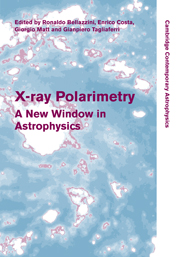Book contents
- Frontmatter
- Contents
- List of contributors
- Preface
- 1 X-ray polarimetry: historical remarks and other considerations
- Part I Polarimetry techniques
- 2 Scattering polarimetry in high-energy astronomy
- 3 Photoelectric polarimeters
- 4 Bragg crystal polarimeters
- 5 X-ray polarimetry with the photon-counting pixel detector Timepix
- 6 High-energy polarized photon interactions with matter: simulations with Geant4
- 7 The GPD as a polarimeter: theory and facts
- 8 Ideal gas electron multipliers (GEMs) for X-ray polarimeters
- 9 Broad-band soft X-ray polarimetry
- 10 Feasibility of X-ray photoelectric polarimeters with large field of view
- 11 Angular resolution of a photoelectric polarimeter
- 12 Development of a Thomson X-ray polarimeter
- 13 Hard X-ray / soft gamma-ray polarimetry using a Laue lens
- Part II Polarized emission in X-ray sources
- Part III Future missions
- Author index
- Subject index
5 - X-ray polarimetry with the photon-counting pixel detector Timepix
from Part I - Polarimetry techniques
Published online by Cambridge University Press: 06 July 2010
- Frontmatter
- Contents
- List of contributors
- Preface
- 1 X-ray polarimetry: historical remarks and other considerations
- Part I Polarimetry techniques
- 2 Scattering polarimetry in high-energy astronomy
- 3 Photoelectric polarimeters
- 4 Bragg crystal polarimeters
- 5 X-ray polarimetry with the photon-counting pixel detector Timepix
- 6 High-energy polarized photon interactions with matter: simulations with Geant4
- 7 The GPD as a polarimeter: theory and facts
- 8 Ideal gas electron multipliers (GEMs) for X-ray polarimeters
- 9 Broad-band soft X-ray polarimetry
- 10 Feasibility of X-ray photoelectric polarimeters with large field of view
- 11 Angular resolution of a photoelectric polarimeter
- 12 Development of a Thomson X-ray polarimeter
- 13 Hard X-ray / soft gamma-ray polarimetry using a Laue lens
- Part II Polarized emission in X-ray sources
- Part III Future missions
- Author index
- Subject index
Summary
We investigated the capability of the hybrid photon counting pixel detector Timepix to measure the degree of linear X-ray polarization between 27 and 84 keV. Due to its ability to measure energy deposition or the detection time in each pixel, both photoelectric effect and Compton scattering in the sensor can be exploited. The analyzing power exploiting photoelectric effect was found to be small compared to X-ray-sensitive CCDs due to the larger pixel pitch (55 μm) of the Timepix. We were able to measure a polarization asymmetry of (0.96±0.02)% between vertical and horizontal double-hit events in neighbouring pixels. The polarization asymmetry was measured with dependence on the energy deposition in the sensor. Asymmetries range between 0.2% at 29 keV and 3.4% at 78 keV. In order to exploit the polarization signature of Compton scattering in the sensor, the time-to-shutter mode of the Timepix was used. We measured a large modulation factor of about 68.1% in good agreement with simulations.
Introduction
It has already been demonstrated that X-ray-sensitive CCDs can be used to measure the degree of linear polarization of X-rays using the effect that photoelectrons are emitted with a nonisotropic angular distribution with respect to the orientation of the electric field vector of impinging photons. Up to the last year hybrid semiconductor pixel detectors like the Timepix-detector have never been used for X-ray polarimetry. The main reason for this is that the pixel pitch is large compared to CCDs which results in a much smaller analyzing power.
- Type
- Chapter
- Information
- X-ray PolarimetryA New Window in Astrophysics, pp. 42 - 47Publisher: Cambridge University PressPrint publication year: 2010

